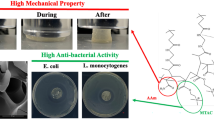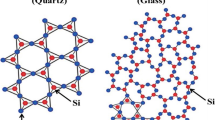Abstract
Mesoporous thiol and guanidine-modified silicas with narrow pore size distribution have been prepared by the sol–gel technique. The surface area of the silicas was modified by treatment with 3-mercaptopropyltrimethoxysilane (MPTMS) and the guanidine polymers polyacrylate guanidine (PAG) and polymethacrylate guanidine (PMAG). The mesoporous silicas were characterized by nitrogen adsorption–desorption analysis, Fourier transform infrared spectroscopy, and laser diffraction. The materials obtained were used as adsorbents for removing heavy metal ions (Cu2+) from water. It was found that modification of the silica surface by treatment with MPTMS and guanidine polymers provides new sorbents with high adsorption capacity compared with unmodified silica. The equilibrium adsorption capacity for Cu2+ ions on the surface of silicas modified by PAG and PMAG was 65 and 99.8 mg/g, respectively. Moreover, the modified silicas were tested for antimicrobial activity, in vitro, against the Gram-positive prokaryote Staphylococcus aureus and the Gram-negative prokaryote Escherichia coli. The results showed that only silica modified with guanidine polymers had high antimicrobial activity. To summarize, silica modified by treatment with guanidine polymers is more effective than thiol-modified silica for removing heavy metal ions from aqueous solution and can also be used as a biocide for surface sterilization.










Similar content being viewed by others
Change history
20 November 2023
A Correction to this paper has been published: https://doi.org/10.1007/s11164-023-05154-9
References
P. Polroniczak, S. Kowalak, J Porous Mater 18, 703 (2001)
W. Shengju, F. Li, X. Ran, S. Wei, G. Li, J Nanopart Res 12, 2111 (2010)
D. Liu, J.H. Lei, L.P. Guo, X.D. Du, K. Zeng, Microporous Mesoporous Mater 117, 67 (2009)
B. Thomas, N. Baccile, S. Masse, C. Rondel, I. Alric, J Sol-Gel Sci Technol 58, 170 (2011)
L.K. Neudachina, A.Y. Golub, Y.G. Yatluk, V.A. Osipova, Y.A. Berdyugin, E.M. Gorbunova, L.V. Adamova, Inorg Mater 47, 435 (2011)
N.V. Guzenko, O.E. Voronina, N.N. Vlasova, E.F. Voronin, J. Appl. Spectr. 71, 141 (2004)
M. Zougagh, J.M. Cano Pavon, A. Garcia de Torres, Anal Bioanal Chem 381, 1103 (2005)
Y.C. Feng, Y. Meng, F.X. Li, Z. Ping, J.W. Xue, J Porous Mater (2013). doi:10.1007/s10934-012-9617-7
A. Morikawa, Y. Yamaguchi, H. Kakimoto, Y. Imai, Chem Mater 6, 913 (1994)
A. Faliagas, J. Sfyrakis, J. Simitzis, J Mater Sci 31, 199 (1996)
E. Guerrero et al., J Porous Mater (2012). doi:10.1007/s10934-012-9608-8
S.B. Savvin, V.P. Dedkova, O.P. Shvoeva, Russ Chem Rev 69, 187 (2000)
N. Sivov, S. Khashirova, Y. Malkanduev, M. Baidaeva, Modern Tendencies Org Bioorga Chem 27, 310 (2008)
S. Asuha et al., J Porous Mater 18, 581 (2011)
L.L. Hench, K. Jon, West Chem. Rev. 90, 33 (1990)
J. Brunauer, P. Emmet, E. Teller, J Am Chem Soc 60, 309 (1938)
E.P. Barrett, L.G. Joyner, P. Halenda, Ibid 73, 373 (1951)
Z. Cheng, A. Yasukawa, K. Kandori, T. Ishikawa, J. Chem. Soc. FaradayTrans. 94, 1501 (1998)
Y. Xu, L. Axe, J Colloid Interface Sci 282, 11 (2005)
J. Mohan, Organic Spectroscopy: Principles and Applications, 2nd edn. (Narosa Publishing House, New Delhi, 2008), p. 548
X.M. Xue, F.T. Li, Microporous Mesoporous Mater. 116, 116 (2008)
Acknowledgments
We thank Dr Khashirova S. Yu., Department of Macromolecular Compounds, The Kabardino-Balkar State University by N. M. Berbekova, for synthesis of guanidine polymers. The work is supported by the Grant of the RFBR (Project No. 12-03-31309).
Author information
Authors and Affiliations
Corresponding author
Additional information
The original online version of this article was revised: The figure 3 caption is corrected as "FTIR spectra: unmodified silica (1), PAG-modified silica (2), PMAG-modified silica (3)”
Rights and permissions
About this article
Cite this article
Timin, A., Rumyantsev, E. Novel biocide multifunctional materials based on mesoporous silicas modified by treatment with guanidine polymers or mercaptopropyltrimethoxysilane: synthesis, characterization, and applications. Res Chem Intermed 41, 2437–2451 (2015). https://doi.org/10.1007/s11164-013-1358-y
Received:
Accepted:
Published:
Issue Date:
DOI: https://doi.org/10.1007/s11164-013-1358-y




